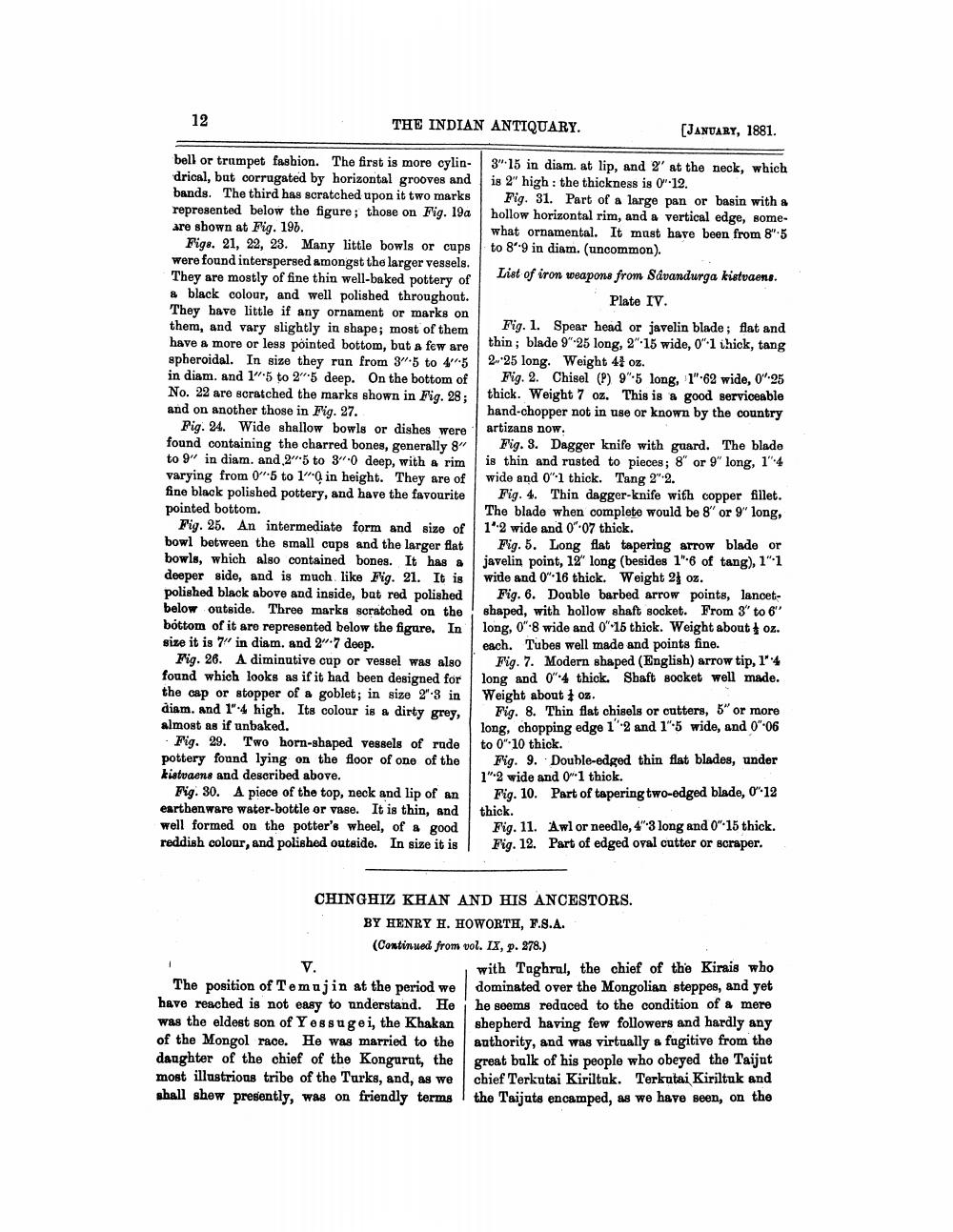________________
12
THE INDIAN ANTIQUARY.
(JANUARY, 1881.
bell or trumpet fashion. The first is more cylin- 3.15 in diam at lip, and ?' at the neck, which drical, but corrugated by horizontal grooves and is 2" high : the thickness is 0.12. bands. The third has scratched upon it two marks Fig. 31. Part of a large pan or basin with a represented below the figure; those on Fig. 19a hollow horizontal rim, and a vertical edge, someare shown at Fig. 196.
what ornamental. It must have been from 8"5 Fig. 21, 22, 23. Many little bowls or cups to 8:9 in diam. (uncommon). were found interspersed amongst the larger vessels. They are mostly of fine thin well-baked pottery of
List of iron weapons from Savandurga kistvaens. # black colour, and well polished throughout.
Plate IV. They have little if any ornament or marks on them, and vary slightly in shape; most of them
Fig. 1. Spear head or javelin blade; flat and have a more or less pointed bottom, but a few are
thin; blade 9"-25 long, 2":15 wide, 0"I thick, tang spheroidal. In size they run from 35 to 4"-5 2.-25 long. Weight 41 oz. in diam. and 1" 5 to 25 deep. On the bottom of Fig. 2. Chisel (R) 995 long, 1"-62 wide, 04-25 No. 22 are scratched the marks shown in Fig. 28;
thick. Weight 7 oz. This is a good serviceable and on another those in Fig. 27.
hand-chopper not in use or known by the country Pig. 24. Wide shallow bowls or dishes were | artizans now. found containing the charred bones, generally go Fig. 3. Dagger knife with guard. The blade to 9" in diam, and 2-5 to 3.0 deep, with a rim is thin and rusted to pieces; 8" or 9" long, 1"-4 varying from 0:5 to 1"Q in height. They are of wide and 0'1 thick. Tang 2.2. fine black polished pottery, and have the favourite Fig. 4. Thin dagger-knife with copper fillet. pointed bottom.
The blade when complete would be 8' or 9' long, Fig. 25. An intermediate form and size of 1-2 wide and 0:07 thick. bowl between the small cups and the larger flat Fig. 5. Long flat tapering arrow blade or bowls, which also contained bones. It has a javelin point, 12' long (besides 1"6 of tang), 1"1 deeper side, and is much like Fig. 21. It is wide and 0 16 thick. Weight 2} oz. polished black above and inside, but red polished Fig. 6. Double barbed arrow points, lancetbelow outside. Three marks scratched on the shaped, with hollow shaft socket. From 3 to 6" bottom of it are represented below the figure. In long, 0":8 wide and 0"-15 thick. Weight about oz. size it is 7" in diam, and 2-7 deep.
each. Tubes well made and points fine. Fig. 26. A diminutive cup or vessel was also Fig. 7. Modern shaped (English) arrow tip, 1:4 found which looks as if it had been designed for long and 0-4 thick. Shaft socket well made. the cap or stopper of a goblet; in size 2.8 in Weight about 1 oz. diam. and 1"-4 high. Its colour is a dirty grey, Fig. 8. Thin flat chisels or cutters, 5" or more almost as if unbaked.
long, chopping edge 1"2 and 195 wide, and 0"-06 - Fig. 29. Two horn-shaped vessels of rade to 010 thick. pottery found lying on the floor of one of the Fig. 9. Double-edged thin flat blades, under kistvaens and described above.
1"-2 wide and 01 thick. Fig. 30. A piece of the top, neck and lip of an Fig. 10. Part of tapering two-edged blade, 0912 earthenware water bottle or vase. It is thin, and thick. well formed on the potter's wheel, of a good Fig. 11. Awl or needle, 4"3 long and 0“15 thick. reddish colour, and polished outside. In size it is Fig. 12. Part of edged oval cutter or scraper.
CHINGHIZ KHAN AND HIS ANCESTORS.
BY HENRY H. HOWORTH, F.S.A. (Continued from vol. IX, p. 278.)
with Taghrul, the chief of the Kirais who The position of Temujin at the period we dominated over the Mongolian steppes, and yet have reached is not easy to understand. He he seems reduced to the condition of a mere was the eldest son of Yessugei, the Khakan shepherd having few followers and hardly any of the Mongol race. He was married to the anthority, and was virtually a fagitive from the daughter of the chief of the Kongurut, the great bulk of his people who obeyed the Taijnt most illustrions tribe of the Turks, and, as we chief Terkutai Kiriltak. Terkutai Kiriltuk and shall shew presently, was on friendly terms the Taijuts encamped, as we have seen, on the




